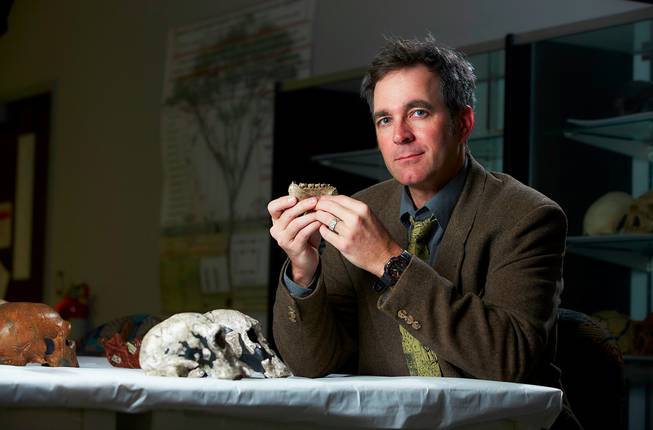
COURTESY: UNLV
UNLV anthropologist Brian Villmoare examines a replica of a 2.8-million-year-old human jaw.
Wednesday, March 4, 2015 | 5:56 p.m.
Forget dirty old coins, imagine digging this up in your backyard:
A small group of international researchers including UNLV anthropologist Brian Villmoare announced today that they have found the oldest early human fossil ever, at 2.8 million years old.
The fossil, a jaw bone which the group found in 2013 on a hill in northern Ethiopia, is the earliest evidence of the genus Homo, which includes modern humans.
The group finally published their report on the fossil today in Science, triggering an avalanche of media coverage around the world. The fossil predates any other similar finding by around 400,000 years, Villmoare said.
“Even though it does tell us some important things, there obviously is a lot more that we’d like to know that we don’t know,” Villmoare said. “At least this tells us where to look and what to look for.”
The jaw’s intact teeth show a distinct resemblance to the Homo lineage, while its sloped chin clearly links it to much older ancestors.
The finding bridges a nearly 500,000 year gap in the fossil record when it comes to early human ancestors. While scientists have found fossils dating back 3 million years as well as fossils dating back 2.4 million years, the period in between had been murky until now.
“We come in 3 million years ago looking like an ape and come out 2 million years ago looking more like a human,” he said. “So we wanted to see what happened during that intervening million years.”
Villmoare said the fossil proved that the early Homo had been around for much longer than scientists previously thought. The fossil dates to around 200,000 years after the presence of Australopithecus, the ape-like ancestor to the more human-looking Homo.
Though that may seem like an impossibly long time, it’s very short in anthropological terms, according to Villmoare. He said it suggested a period of rapid evolution caused by changes in the climate.
The research group had been searching for fossils from the period since 2002. Villmoare started on the project as a graduate student before becoming a leading member in 2008.
He often camped out for six weeks with his peers in the country’s Ledi-Guraru research site, miles away from the nearest village. He was working at the site the day fellow scientists found the fossil.
“I was on the other side of the hill so I heard them all yelling,” he said. “We recognized right away what it was.”
Until then the group braved searing temperatures and dusty conditions, and many fell ill.
Villmoare was the lead author of the report, which took a year to write but only months to finalize for publication.
“Our position was, let’s get it out there so a lot of people can test our hypotheses,” he said.

Join the Discussion:
Check this out for a full explanation of our conversion to the LiveFyre commenting system and instructions on how to sign up for an account.
Full comments policy